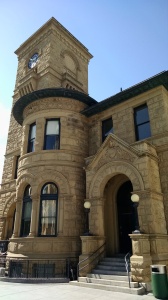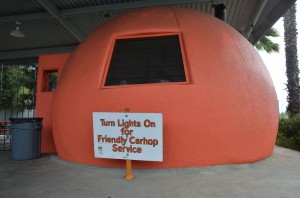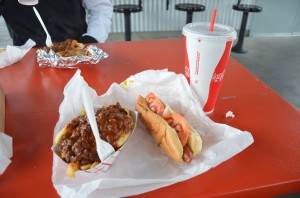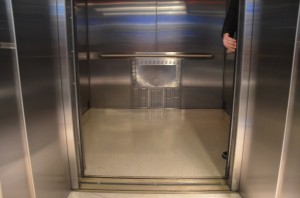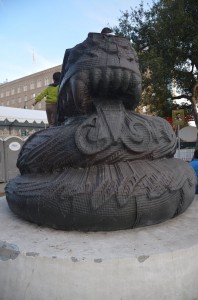Get to know Quetzy! Your friendly neighborhood feathered serpent wants to hang out! Pick some San Jose threads for Quetzy, and take him around town with you!
Being Three Faced: The Unsolved Mystery of the San Jose Clock Tower
Sarah Winchester’s crib isn’t the only mysterious edifice in San Jose.
It might be the fact that I watched Back to the Future this weekend and have clock towers on the brain, but I had the urge to explore an understated San Jose mystery: why the historic San Jose Clock Tower only has three faces. There is a circular indentation where the fourth clock—facing east—would be affixed, but alas, it remains empty. Conspiracy? A matter of structural integrity? Bizarrely obvious oversight?
Before we speculate on that, let’s look at some facts:
- The clock tower was built in 1892…not a great year for the birth of a building since a bit over a decade later many of them would come crumbling down in the 1906 earthquake. And crumble down it did.
- In 1908 the city began reconstructing the tower, a project that never fully reached completion.
- The clock inside is a famed Nels Johnson Century Tower Clock which isn’t just your average, run of the mill Swatch. At the time, it was one of the finest clocks available (yet another mystery is why San Jose was chosen to receive such a gift), and is speculated to be “the first high-tech instrument built in San Jose.” Today it needs to be hand-wound, but is evidently still ridiculously accurate, to within a few seconds over a month.
- And most importantly—be sure to soak this in— the original clock tower did, in fact, have four clock faces.
No one seems to know why the clock tower only has three faces today, not even those responsible for its preservation and restoration efforts. In response to my hard-hitting, investigative interrogation (“Would you be so good as to let me know why there are only three faces on the San Jose Clock Tower please?”) I got this response:
Hello Jordan. No one knows why the clock tower only has 3 faces. The original tower did indeed have the fourth face. You can see a picture of it on the FB page.
Wolf Blitzer I am not.
Perhaps no one does know for sure why the clock is the way it is, but theories abound. Here are a smattering.
Not giving the east side the time of day
Theory number one—which happens to be the one I’ve heard the most—is that the missing clock is a cheap shot to the east side. Why? Who knows. It’s not the first clock in history to include only 3 faces, intentionally slighting a side of town they were not particularly fond of. (A number of clocks in England, for example, are purported to have excluded a fourth clock face for this reason).Those involved with the restoration debate whether or not to include the fourth face, and there’s absolutely no reason not to. In an interview with The Metro, John Mitchell, who is spearheading the restoration efforts, made this remark:
“‘If we don’t [add the fourth face], then people on the East Side will complain,’ Mitchell says. “They’ll say, ‘What, d’ya think the East Side isn’t good enough?'” (Knowing San Jose, that’s probably exactly what would happen.)”
Yet sources point to “no” on adding the fourth face. Sorry east side; you’ll have to resort to sun dial.
Wondering “weather” or not to do it
Seeing that the sun rises in the east, one school of thought believes that the weather-induced wear and tear of the clock would become an eyesore, particularly compared to the other faces. However, one would presume that if we can preserve centuries-old Italian frescoes, surely we could weather-guard a clock.
Time is money, people
One clock tower in England, paid for by public subscription, had either an ironworking business or shipyard that refused to pay for a fourth clock face because employers on that side of the clock didn’t want their employees wasting time “clockwatching.” In Silicon Valley, we’re all about productivity. So this theory makes an iota of sense that could promote it from “laughable” to “plausible.”
The question remains: will we ever solve the mystery of the clock? Will it ever be returned to its original form? And will they ever add the elusive fourth face?
Only time will tell.
Heard (or want to start) any other theories? Do tell!
Looking back a few decades
For those of you familiar with the San Jose downtown, take a ride in the San Jose Time Machine and check out the landscape in 1975 compared with today. (You’ll be amazed what’s still there!)
http://www.sjredevelopment.org/PublicationsPlans/SanJose1975.pdf
The Holy Trinity of San Jose Attractions
We here at Searchlight SJ focus on all things uniquely unusual and fun about San Jose so that you can stop yourself the next time you start to say to a visitor or friend that there is nothing to do in San Jose except go to Santana Row, the Winchester Mystery House, or a Sharks game. That’s not to say that we want to stop you from promenading around the Row, touring Sarah’s beautiful but bizarre mansion, or taking in a game from the best hockey team in the world, in fact, we encourage it! Best of all, these three oft visited San Jose hot spots have some zany attributes that we love and that you’ve probably never known:
Santana Row: San Jose’s answer for Rodeo Drive has quickly become a go to for expensive clothes, fine dining, and exhibiting adoration for all things upper class. Santana Row doesn’t just attract the rich and famous of the South Bay, it has also hosted its fair share of well known national personalities including Bill Clinton. The former President stopped by Rosie McCann’s during a 2004 book tour for dinner and, among other things, a mango mojito (because nothing says Irish pub like mango and mojito). Stop by Rosie’s and check out the photo of Clinton’s visit near the entrance but please, order a Smithwicks instead.
Winchester Mystery House: You’ve undoubtedly visited this California State Landmark on fieldtrips or while entertaining out of town guests and may feel like you could give the admittedly pricey tour. The next time your uncle is visiting fear not, there’s plenty more to be learned and seen in the mansion. The key to a good experience at the Mystery House is a quality guide. To minimize the chance of an overly scripted guide avoid summer months and try for a morning or early afternoon tour. If you still find yourself growing disinterested and need a way to spook your nephews ask your guide about the Hall of Heads. For years the Winchester House hosted a wax museum that focused on the history of Winchester and the rifle. In the 70’s the wax museum was disassembled and replaced by the current rifle museum and its wax figures were dismembered with it. Various waxy body parts are stored in un-toured rooms of the mansion including one room dedicated to the heads of the historical characters. If you’re lucky enough to end up on a small tour and with an adventurous guide the room can be seen (if you ask nicely) after touring the Grand Ballroom.
San Jose Sharks: A trip to the Shark Tank remains one of the hottest tickets in town and we can say (with bias) one of the best sporting environments around. Everyone knows that the Sharks’ winning ways haven’t been able to carry them to the Stanley Cup but since 1991 San Jose has built a respected and already storied franchise with a history that includes the only NHL game ever to be rained out. In March of 1995 downtown’s mighty Guadalupe River flooded its banks thanks to torrential rain and poorly constructed spillways and covered Highway 87 and nearly every road into the arena with several feet of water. While the floodwaters did not reach the arena the rain did not cease and the water continued to rise thus forcing the NHL to declare the game with the Detroit Red Wings a rain out, the first and only rain out in the league’s history. Check out the pictures of a flooded 87 and Guadalupe flood cycles (if you’re into that sort of thing) at the Oakland Museum of California’s website.
Hot Dog!
A culinary trip to east San Jose conjures up thoughts of the delicious Salsa Festival, a bowl of warm Pho on a cold day, or brightly colored helados from a push cart. Chances are you don’t think of classic style hot dogs when you head east of 101 however at Mark’s Hot Dogs at 48 South Capitol Ave that’s exactly what you’ll find. What may be the last San Jose restaurant to provide carhop service Mark’s has been serving up delicious dogs since 1936 out of a tiny round orange building that can only be described as Flinstonian.
The hot dog stand has moved several times in the last 75 years and most recently relocated to its current location in 2000. Fortunately the unique hut has remained intact and proves to be impossible to miss if you happen to drive by. While the dogs won’t send ripples through the restaurant world they are big, messy, and cheap and above all the novelty of being served meat products in your parked car out of a building that looks like a big piece of fruit makes the trip well worth it.
Secrets of the Library
What does a secret hiding spot, a hilarious window, and a really creepy lock of aged hair have in common? They’re all part of the Dr. Martin Luther King Jr. library in San Jose, which is so much more than a bunch of books and college students half-reading them. If you’re meandering through downtown, stop in at the library and check out these hidden gems along with a favorite book:
Secret in the Browsing Library: On the first floor of the library in the area labeled “Browsing Library” you’ll find a Harry Potter-esque secret hiding space. One of the bookshelves, when pushed, will swing open and reveal a space large enough to hide inside.
The Reason Why San Jose is the North American Vienna: Thanks to a donation in the early ‘80’s by avid Beethoven collector, Ira F. Brilliant, the DMLK library’s third floor houses the largest collection of Beethoven paraphernalia outside of Europe. An impressive collection of fortepianos, manuscripts in Beethoven’s own handwriting, and…yes…a now famous lock of Beethoven’s hair (clipped off of his dead body by a visitor to the funeral home where he was temporarily housed *shudder*), make this museum a must-see if you’re making your way through the library’s oddities.
Alice’s Adventures in the Elevator: In the southernmost elevator on the first floor of the library, you’ll see a door that is totally inefficient for anyone riding up to check out a science textbook, but just perfect if you’re 2 feet tall and fixing to go to Wonderland. The door, otherwise known as the “Hatch,” is a work of art by Mel Chin, who contributed to artistic installations throughout the library.
The Burned and the Banned: Throughout the library are bookshelves that stand over “vaults” of books that have been burned or otherwise banned in the past.
Wisecracking Windows: On the 7th floor bridge you’ll find a window paying homage to artist Marcel Duchamp’s “Large Glass.” Look closely and you’ll find that the cracks are comprised of eensy-weensy etched jokes and puns.
Am I hearing things?: On the third floor around call numbers 642-658, you’ll hear the sound of pages turning above you followed by the sound of a book closing as you reach the end of the row.
Finish your trip to the library with a literature-themed sandwich from On Fourth: A Novel Café on the ground floor. (I highly recommend the “Great Gatsby!”) For a complete list of oddities to round out your library scavenger hunt, visit http://www.sjlibrary.org/melchin-art-list.
No waiting at the Blue Cube!
One of the main features of the former Naval Air Base at Moffett Field, outside of San Jose, is Onizuka Air Force Station. Known colloquially as “The Blue Cube”, the large, windowless blue building is the subject of no small speculation in the area. Until its recent decommissioning, the building was known to house an Air Force satellite control center, suspected to the MAIN satellite control facility for much of the United States’ satellite inventory. The building was, perhaps unsurprisingly then, rumored to be the world’s prime nuclear target. Meaning that if the bombs started falling, Mountain View would be the first place to go. Let’s do a little math here. Moffett Field is about 11 miles from the heart of San Jose. A 25 megaton nuclear bomb (about half the size of the largest ever tested) has an utter destruction radius of about…well…11 miles. Given the blast expansion formula R=S(Et^2/p)^(1/5) where R equals the radius of the blast, E the energy, and t the time, we get (17,700m)^5*1.3kg/m^3 = ~1(1.05×10^16J * t^2s), so…t^2s = 21,509, meaning…that about 2 minutes and 26 seconds after WWIII officially started, your watch would stop working. It’s probably for the best, really, because you wouldn’t need it after that; all your appointments from that moment forward would be of the more…eternal…sort. Anyway, Greetings from Sunny San Jose!
Sources: profligate hearsay, wikipedia.org, and nationalterroralert.com
Togo’s – The Better Way to Travel with Hunger
No report on the culinary features of San Jose would be complete without a mention of what is perhaps San Jose’s most famous edible offspring: Togo’s Sandwiches. Started in San Jose in 1971, the single shop has grown to a chain of 240 locations on a platform that boils down to: ‘Our sandwiches are bigger than theirs.’ (Theirs in this case, being that other sandwich shop, the one that takes as their namesake the dirtiest of transportation systems – interesting choice if you ask me) And while it’s true that Togo’s sandwiches are larger (and served on something that far better approximates real bread) I would have to state that their offerings seem to have gotten less “larger” over the years, while still maintaining a calculable edge. I seem to recall a time when the sandwiches were almost dauntingly large, the amount of meat on them visibly outweighing the amount of bread. Sadly, they have been acquired by a corporate conglomerate (probably more than once) and their sandwiches today are far more normally proportioned, but still tasty and always fresh. If you’re looking for a healthy lunch on the West Coast, Togo’s will certainly factor prominently on your ‘fast & fresh’ radar.
Sources: togos.com
The Happiest Little House
One of the beautiful things about living in a large city is the variety of food that is available, allowing you to stretch yourself beyond the national food chains (whose menus are predicated upon the lowest common taste denominator). A little place that I especially enjoy (and a San Jose original) is a fast food teriyaki joint known as Happi House. Started in 1976 in San Jose’s Japantown, the restaurant known for its fast, “California” style teriyaki became a chain, with a current six locations around the San Jose area. A great place to go for quick bite, the chain serves both meals and a la carte style food, with the meals generally consisting of a central meat choice, accompanied by their Asian chicken salad, white or brown (beef) rice, and a few pieces of tempura. The real draw here is the teriyaki sauce. I don’t know what they put in it (they say that they don’t add any MSG) but the stuff is ADDICTIVE. The spicy teriyaki sauce is especially delicious, and a step outside the usual. You can even buy a bottle to take home if you like (oh, and I do!) Visit the updated original Japantown location off Taylor and 5th for extra urban originality points!
Sources: happihouse.com
Dookie in the Park
Ascending nearly 8 feet into the sky above Plaza de Cesar Chavez in San Jose, is the “plumed serpent,” a fearsome Aztec deity, the anthropomorphic god of the morning star…who, very unfortunately, resembles a pile of you-know-what.
Yes, San Jose’s “Quetzalcoatl” is a big, brown, steaming pile of…artistic iteration….that based on its weirdness alone makes it worthy to be visited. Erected in 1994 in downtown San Jose, this sculpture has left many confused, few inspired, but all interested in learning—why oh WHY would we let this statue reside at the end of such a prominent San Jose park?
Now, don’t all go blaming Richard Graham- San Jose’s Quetzalcoatl sculptor who was commissioned to make a piece that would honor the city’s Mexican heritage. We possibly have author D.H. Lawrence to thank for this particular rendition of the ubiquitous Aztec god based on Lawrence’s note in 1926, that existing statues of Quetzalcoatl in Mexico were “coiled like excrement.” Graham’s original vision- one of multicolored bronze, three stories high- was given the big “deny” stamp by San Jose. What they got instead was, well, visit the Plaza de Cesar Chavez and see for yourself. D.H. Lawrence…what hath thou wrought?!
If you’re anything like us you may often be tempted to string Quetzalcoatl in Christmas lights or put him in a Santa hat or dress him in an oversize bikini in the summertime. Beware! We assume that the fine for dressing up, a.k.a. “defacing” the $500,000 landmark would be extremely costly, not to mention that a charge of “getting arrested for dressing up a humungous turd like a pirate” would be a difficult blot on any permanent record to explain. Thusly, we urge anyone tempted to give our coiled colon-release a makeover to perhaps just Photoshop a Santa hat in.

